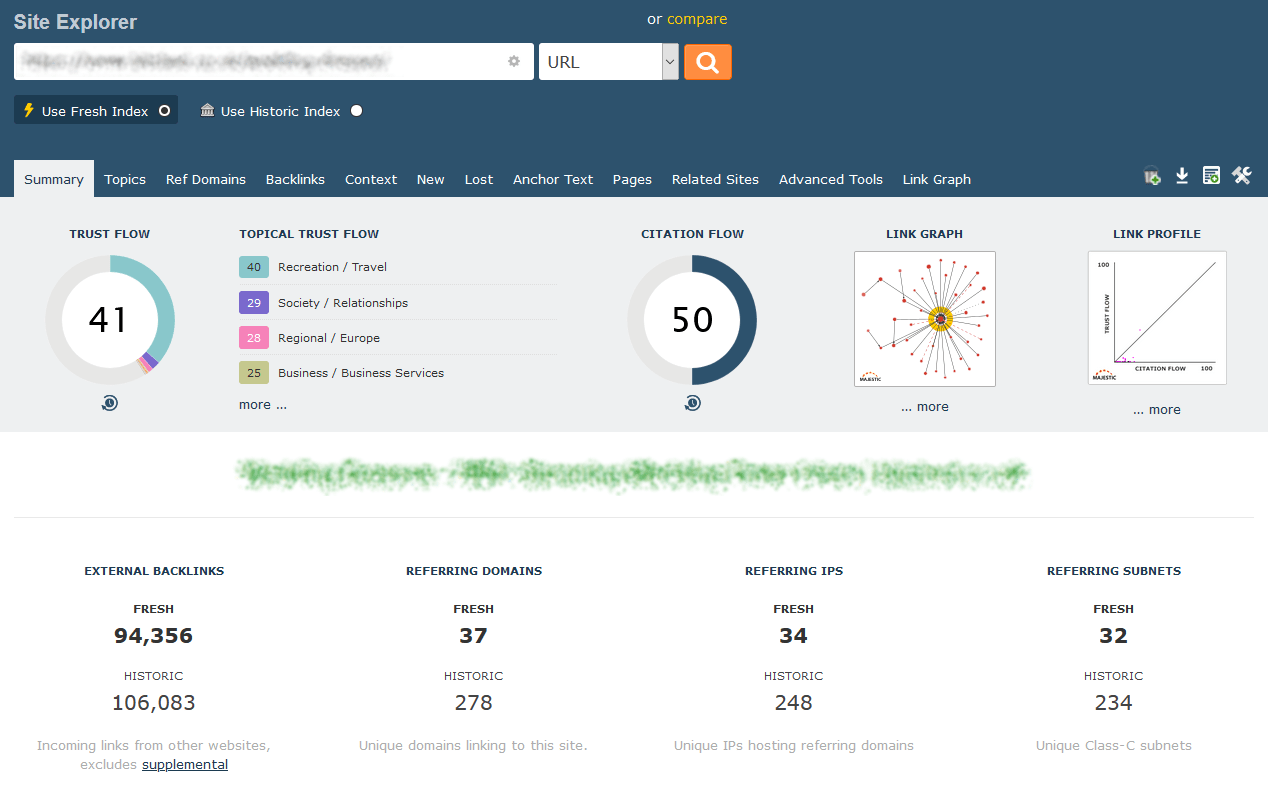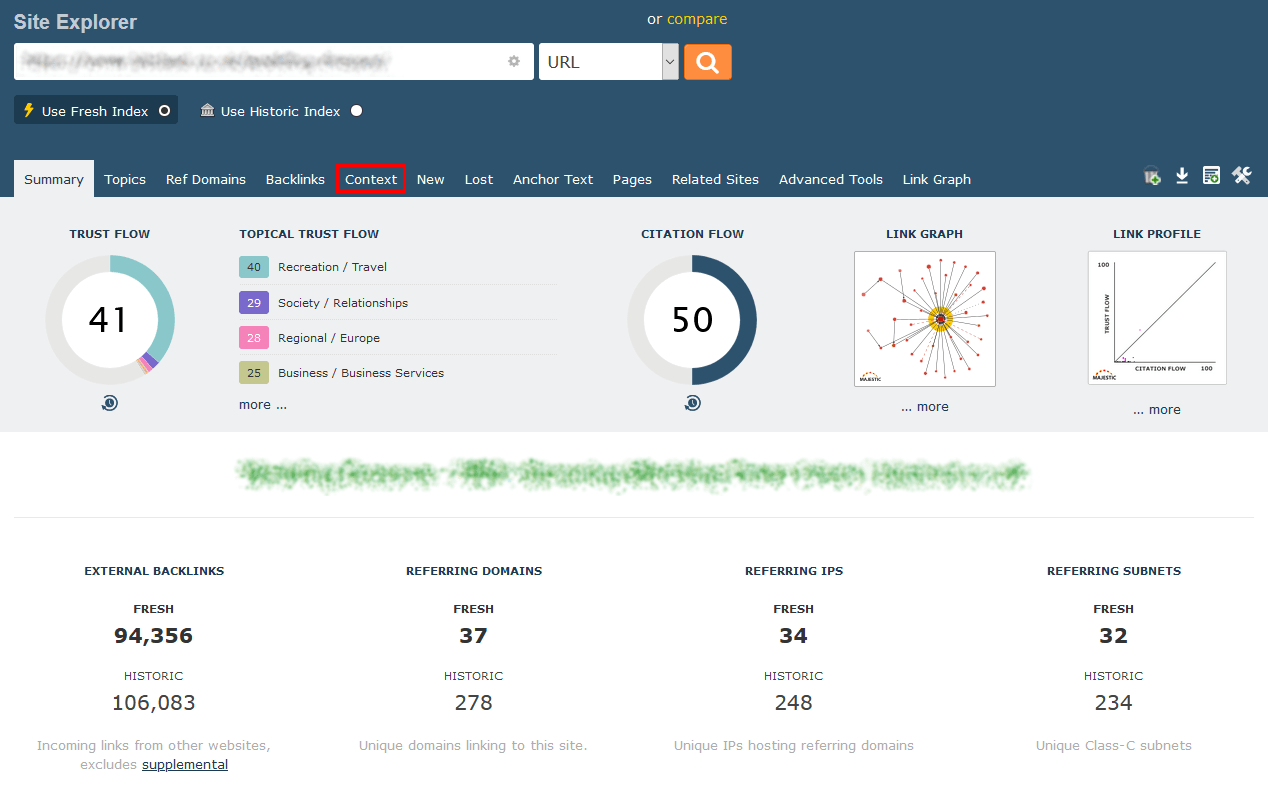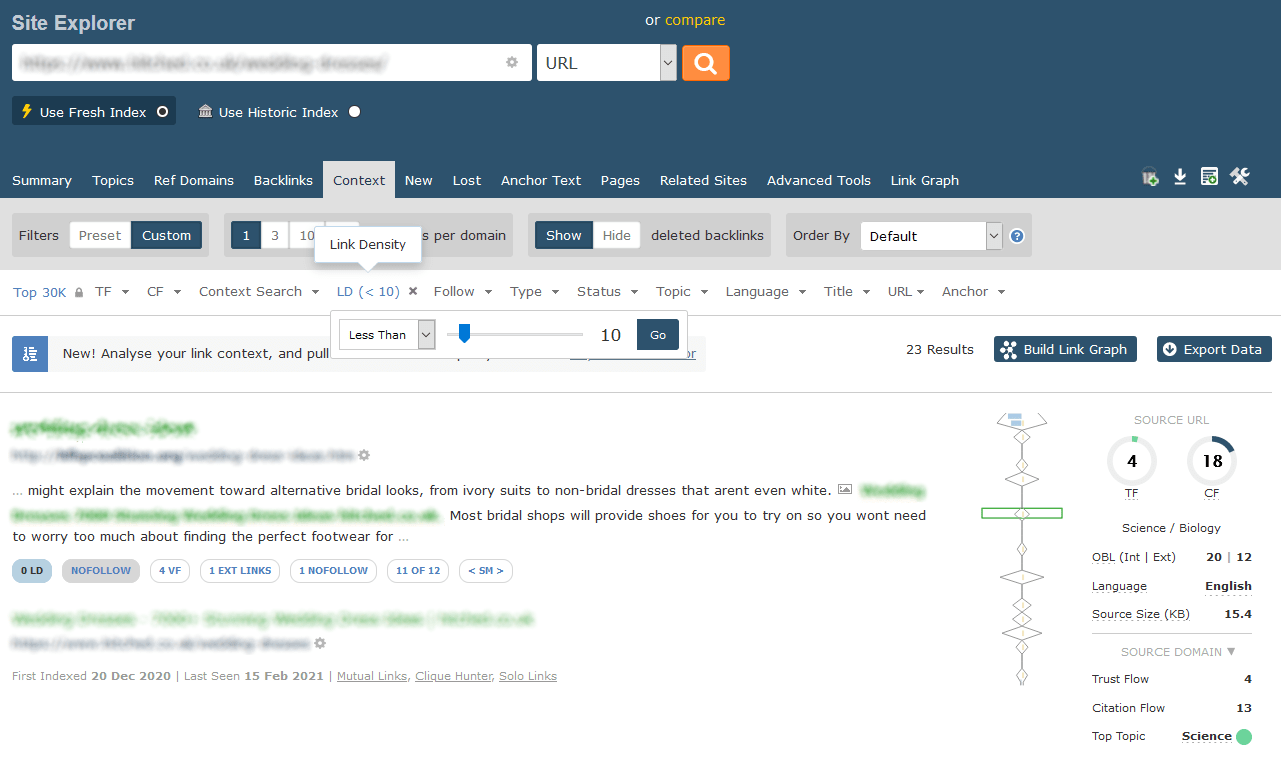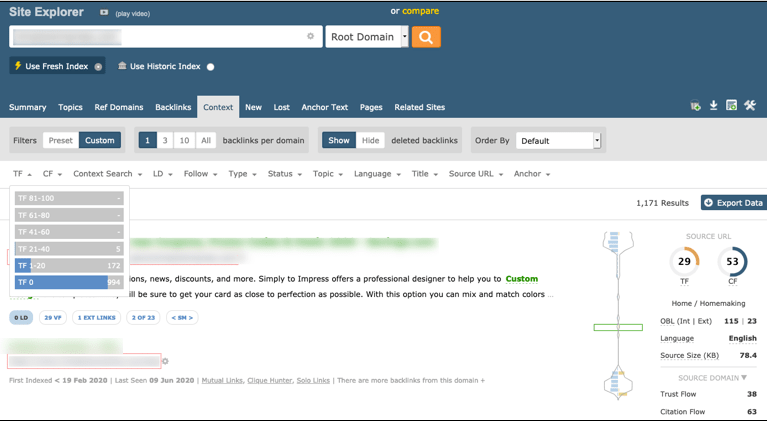-
Site Explorer
- Majestic
- Summary
- Ref Domains
- Backlinks
 New
New Lost
Lost- Context
- Anchor Text
- Pages
- Topics
- Link Graph
- Related Sites
- Advanced Tools
- Author ExplorerBeta
- Summary
- Similar Profiles
- Profile Backlinks
- Attributions
- Compare
-
Link Tools
- My Majestic
- Recent Activity
- Reports
- Campaigns
- Verified Domains
- OpenApps
- API Keys
- Keywords
- Keyword Generator
- Keyword Checker
- Search Explorer
- Link Tools
- Bulk Backlinks
- Neighbourhood Checker
- Submit URLs
- Experimental
- Index Merger
- Link Profile Fight
- Mutual Links
- Solo Links
- PDF Report
- Typo Domain
- Free SEO Tools
- Support
Assessing Quality Backlinks for a top Link Building Strategy
How to Evaluate Backlink Quality for Search Engine Optimisation
Backlinks have always been an integral part of Search Engine Optimisation. Backlinks are an important signal search engines use to rank websites for nearly 20 years. However, the ways in which backlinks impact rankings has evolved. In the beginning, it was a matter of quantity: the more backlinks you had, the better. Having more backlinks than your competitor pointing at a page, was enough to rank ahead of them.
Today, things are different, which is why we need to examine our backlink profile and quantify backlink quality. Quality backlinks are an essential asset in organic placement. As SEOs, we strive to secure the highest backlink quality. But what exactly does this mean? How can we recognise the quality of a backlink and determine if it is good or harmful for our website? There is a grey area when it comes to backlink quality. We address the topic in this article on how to evaluate backlink quality for search engine optimisation.
The difference between a good and a poor backlink is not always clear and easy to understand. Because of this grey zone, we need to understand the concept of backlink quality. Furthermore, SEO agencies are under enormous pressure to industrialise the production of backlinks. As a result, link building can become a stressful activity. This situation can lead to buying backlinks and placing content on websites that may look good, but, in reality, are not. For example, a website may have previously hosted spam and used aggressive tactics, but now hosts legitimate-looking content. Placing a link on such a website with a "soiled" history can hurt your search engine rankings.
In general, websites with low backlink quality will confer little if any value and ranking benefits. At best, search engines will automatically discount such links. If your backlink profile has too many low quality backlinks, you could loose your rankings and the organic traffic you need so badly.
In this article you will learn how to evaluate backlink quality
This article is an in-depth review of backlink quality and why quality backlinks matter. It provides key indicators to evaluate a backlink. In fact, we are going to investigate several factors available in Majestic whihc are used to evaluate the backlinks in your backlink profile. These factors will help you define backlink quality and understand the benefits or disadvantages of backlinks and how a backlink profile can confer an advantage or disadvantage. As we'll see, the difference between a good backlink and a bad backlink isn't easily understandable and clean-cut. In fact, you'll see why we examine links in context and how our judgment on a backlink can change. In the second part of this article, we address the need to shift focus, depending on the circumstances. Backlink quality audits differ from SEO Audits. A backlink quality audit is an analysis used to review link building activities. On the other hand, an SEO Audit will analyse backlinks to identify Spam. In this article you will learn where to look for relevant data to assess the quality of your backlinks.
A Definition of Quality Backlinks
First of all we need to define backlink quality. Like most things in SEO, we do not have a fixed set of rules, procedures or definitions. In fact, there is no such thing as a fixed set of rules and definitions which define backlink quality. The debate is, as usual, open and ongoing. You will find other definitions and opinions that differ from what you'll read in this article. Remember, SEO is more an art than it is a science: it has no fixed boundaries. Definitions and best practices you read about online are often based on empirical evidence, which is why things tend to change quickly.
In search engine optimisation, a quality backlink is DOFOLLOW. When a backlink is DOFOLLOW, both search engines and people are allowed to follow the link. DOFOLLOW backlinks pass so-called link equity (or link juice) which is beneficial to the website they target. The benefit of a DOFOLLOW link is an increase in authority. DOFOLLOW backlinks also confer reputation.
In case you are wondering, let's explain what link equity is before moving on. We mentioned how SEOs informally refer to this metric as "link juice." Link equity is a search engine ranking factor. The concept is one of passing value and authority from one page to another. The value of link equity depends on many factors, such as the linking page's authority and topical relevance. Links which pass link equity are a signal that search engines use to determine a page's rankings in the SERPs.
Secondly, backlinks should sit within the context of a sentence. In other words, links should be in the central area of the article or blog post, and will be less important if they are in the page footer. The website sourcing the backlink should be of high-quality and topically relevant to our page.
A third quality factor is anchor text. The highest quality backlinks use relevant keywords in the anchor text, pointing to a website. Anchor text confers a reputation.
Ideally, a backlink will feature all these qualities. Unfortunately for us, most backlinks do not meet all these criteria. It's quite rare to have backlinks that meet more than a couple of them. Therefore we would be wrong if we focused our attention on this kind of backlink quality as our only objective.
We determine backlink quality based on a spectrum of options. A backlink can be valuable even without all those qualities we would so much like for them to have!
To Summarize:
A quality backlink is one both search engines and users can follow (it does not have a NOFOLLOW Attribute). It is contextual - placed in the content of the web page because the author believed it is a backlink of value for the reader who can follow it and learn more on the subject or learn something new. Lastly, a high backlink quality will strengthen our backlink profile, increase authority and confer a strong reputation.
The Importance of quality backlinks
Backlink quality matters because it is a way to filter attempts to manipulate search engine rankings. In search engine optimisation website owners use techniques in contrast with search engine guidelines to increase their links artificially and rank highly in the SEPRs (Search Engine Results Pages). SPAM Link building schemes, in contrast with Search Engine Guidelines, include:
- purchasing backlinks;
- aggressive DOFOLLOW guest posting;
- exchanging links;
- sophisticated linking strategies,
and much more.
The Search engines detect and de-value with their algorithms backlinks which use many of these techniques.
Backlinks are a significant ranking signal in the search engines
Backlinks are a top-ranking factor, which is why our focus should be mainly on backlink quality, not quantity. One last aspect related to quality is referral traffic to your website. Referral traffic comes from backlinks. Referral traffic consists of visits from other websites. These visits do not originate from a search for you on a search engine.
Relevance of Referring Sources
Once you've established the quality of a website (i.e. it is not spam site), it's best to inspect the backlink and review the content. Take the time you need to check the page that has linked to your website. Ask yourself the following questions:
- Is the backlink relevant to your content?
- What makes this backlink a best fit with your website?
- Why did the webmaster place a link to your content?
If you are satisfied with the answers you can give yourself, then it is very likely the website is legitimate, and there is nothing to worry about: you should be grateful for and proud of the work done by your team to earn quality backlinks.
On the other hand, if you do not have much in common with the website linking out to you, and you have determined it is a spam site, you can disregard the backlink, or you can include the domain in your disavow file. This option will request search engines to disregard it.
Assess Referring Traffic to Your Site
Another aspect of referrals is the amount of traffic a backlink can send to your site and if it is of good quality or not. There are instances where too much traffic is coming from a referral. In these cases, it could be artificial. You've probably heard webmasters ask for help when hackers send traffic to overload a site, making it crash. You don't want any of this bad traffic. If this is your case, you need to do everything in your power to interrupt or distance the connection.
The essence of backlink quality
We base backlink quality both on an individual level and as part of a website's backlink profile. We'll address backlink profile issues in another article of this series. Earlier, we described the ideal backlink. In fact, we stated the best possible backlink to our website would be:
- DOFOLLOW and would pass link equity;
- naturally positioned in the body of an article or blog post;
- theme focused and on-topic with our website;
- characterised by use of keyword-rich anchor text .
Unfortunately, there is no set of rules to establish backlink quality that you can follow: you must evaluate each link. In many cases, you'll need to look at the quality of each link. Website context will play a significant role. Remember, proper Search Engine Optimisation is a delicate balance between the science of ranking and the art of understanding what is happening in the surrounding digital ecosystem. We've spoken about DOFOLLOW backlinks and their benefits, so there is no need for further explanations. What we didn't mention earlier is the opposite of DOFOLLOW, which is NOFOLLOW. All Backlinks from comments in blogs and forums are NOFOLLOW.
Definition of Nofollow Links
Nofollow are backlinks where the webmaster has decided to apply a particular HTML attribute (rel ="nofollow") search engines can read and understand. When we apply the rel= "nofollow" attribute to a backlink, we ask the search engines to ignore the link and not follow through to the linked website. With the rel ="nofollow" attribute, we are taking our distance from a website: we are telling the search engines we don't trust the target website, or we do not want to credit it with the link juice it would get, had we not used the rel="nofollow" attribute.
Speaking about NOFOLLOW backlinks, we specifically used the word ask in the previous paragraph because late last year, in September 2019, Google announced how the NOFOLLOW attribute would evolve and introduced two new backlink attributes:
- The rel="sponsored" attribute to identifiy advertising, sponsorship or similar links;
- The rel="ugc" attribute to identify user generated content links, such as comments and forum posts.
Moving forward, Google will treat these three attributes as hints. Ranking signals now may include NOFOLLOW links. Therefore, search engines may not ignore them, as has been the case up until now.
Position of the Link
The position within an article or blog post is a backlink quality signal. Editorial backlinks are the most valuable. An editorial backlink is a citation by the author, creating a connection between two pieces of content. A backlink in a page footer or a directory type list will have a much smaller impact on our search engine rankings.
Topical relevance
We touched base on the relevance of referring sources earlier in this article. Let's elaborate on the concept of relevance. Search engines detect how "close" two pages are, based on their topical nature. Interlinking between sites on football and sports can be a strong quality signal. Links between software and gardening are more dubious; therefore they are potentially less relevant.
Anchor text relevance
Anchor text is the text of a link users click. Search engines use anchor text as a signal to determine relevance to the linking page. In other words, anchor text is a signal search engines use to determine how the content on the receiving end of the backlink is relevant to the linking page. So, for example, let's consider an article about antivirus software. A link to a page selling hardware would include the word "computer" or something similar - for example anchor text containg the word "hardware". Therefore, backlinks which have keyword-rich anchor text are valuable. But having a link profile with mostly keyword-based anchor text that is over optimised will hurt more than help.
Quality Signals of a backlink for link building in SEO
To audit a link building effort, you need to identify the top quality backlinks in your backlink profile. Link Context is the most important metric, followed by Trust Flow, Citation Flow, and Topical Trust Flow. In this section we are going to explain Link Density.

As an example, we have chosen the URL of a specific page. It was copied and pasted into Site Explorer which returned page level values of these two significant performance indicators. In the screenshot, you can also see Topical Trust Flow value for the main category. You have backlink profile numbers for both the Fresh and the Historic Index.

From here, Click on Context, and you'll open a new page

Our primary focus is on Link Density. This parameter measures how much of the content surrounding a backlink contains other backlinks. High values suggest the presence of a group of backlinks. On the other hand, a low value implies the presence of more text surrounding the backlink. For example, a single backlink inside a paragraph of text would have Link Density equal to zero.
Filtering is easy and powerful. Click and choose the "Less Than" option. For the best editorial backlinks, you'll want a value of 10 or less. If the search does not return any backlinks, loosen filtering. You can filter by backlink quality and download backlinks by clicking on the EXPORT DATA button. The data in this section can also be segmented by Trust Flow, Citation Flow, and Topical Trust Flow.
Backlink quality signals you should look for in an SEO Audit
In an SEO audit, we seek spam backlinks to disavow. A SPAM backlink will have shallow values of Trust Flow. Spam backlinks will often sit on websites with unrelated Topical Trust Flow and they may have an aggressive anchor text pattern, so we must check that too. For an SEO Audit, it makes more sense to run a domain level backlink check. Therefore you should run a domain level query for the same website. Select all the backlinks with a value of zero and download them for further analysis. Here's a tip on how to identify low-level backlinks: When the ratio between Trust Flow and citation flow is much less than 0.5 there could be a quality problem.

Click on TF0 to select backlinks with a value of Trust Flow equal to zero. Click on Export Data, and Majestic will prompt you to download the data in a format of your choice. Proceed to segment the data to analyse anchor text and topical trust flow. Depending on what you find, a second iteration could be necessary. Understanding the quality of your backlinks can be a challenging activity.
What you have learned in this article on quality backlinks
So that wraps it up for this article on how to evaluate a backlink. We've covered what quality backlinks are and how to measure backlink quality. We have identified the most critical parameters used to judge the quality of a backlink profile or a single backlink. We now know what backlink quality is and how it can be measured using Majestic. We've also learned how to use Majestic to audit single backlinks in two distinct situations:
- Verify and examine editorial backlinks - the most valuable kind of link that can boost organic rankings.
- Identify spam backlinks.
Could we improve this page for you? Please tell us